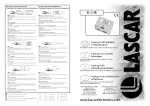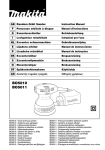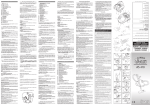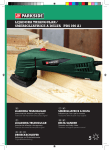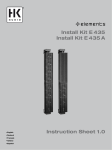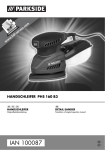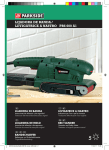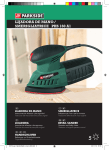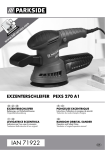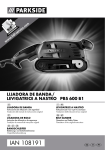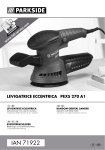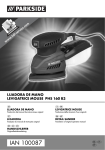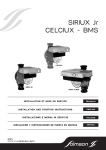Download lijadora excéntrica levigatrice rotorbitale
Transcript
Lijadora excéntrica Levigatrice rotorbitale Antes de empezar a leer abra la página que contiene las imágenes y, en seguida, familiarícese con todas las funciones del dispositivo. Prima di leggere aprire la pagina con le immagini e prendere confidenza con le diverse funzioni dell’apparecchio. Before reading, unfold the page containing the illustrations and familiarise yourself with all functions of the device. Klappen Sie vor dem Lesen die Seite mit den Abbildungen aus und machen Sie sich anschließend mit allen Funktionen des Gerätes vertraut. XQ600 Lijadora excéntrica Kompernaß GmbH Instrucciones de utilización y de seguridad Levigatrice rotorbitale Indicazioni per l’uso e per la sicurezza Burgstraße 21 44867 Bochum (Germany) Orbital Sander Operation and Safety Notes Estado de las informaciones · Versione delle informazioni · Last Information Update · Stand der Informationens: 11 / 2007 · Ident.-No.: XQ600112007-5 EXCENTERSCHLEIFER Bedienungs- und Sicherheitshinweise ES IT / MT GB / MT DE / AT Instrucciones de utilización y de seguridad Indicazioni per l’uso e per la sicurezza Operation and Safety Notes Bedienungs- und Sicherheitshinweise Página 5 Pagina 15 Page 25 Seite 35 10 9 1 8 2 7 3 6 5 A B C D 4 11 Índice Clasificación Uso conforme a lo previsto......................................................................................... Equipamiento............................................................................................................... Volumen de suministro................................................................................................. Características técnicas.............................................................................................. Indicaciones generales de seguridad Lugar de trabajo.......................................................................................................... Seguridad eléctrica..................................................................................................... Seguridad de las personas......................................................................................... Manejo y uso cuidadoso de las herramientas eléctricas........................................ Indicaciones de seguridad específicas para esta pulidora excéntrica ................. Accesorios / equipo adicional oficial........................................................................ ¿Ha comprendido todo?............................................................................................. Página Página Página Página 6 6 6 7 Página 7 Página 7 Página 8 Página 8 Página 9 Página 10 Página 10 Antes de la puesta en marcha Cambio del papel de lija............................................................................................ Página 10 Seleccionar revoluciones y papel de lija.................................................................. Página 10 Puesta en funcionamiento Encender y apagar..................................................................................................... Página 11 Aspiración del polvo................................................................................................... Página 11 Indicaciones de trabajo para el pulido..................................................................... Página 12 Mantenimiento y limpieza....................................................................... Página 12 Eliminación............................................................................................................. Página 12 Información Asistencia..................................................................................................................... Página 13 Declaración de conformidad / Fabricante................................................................ Página 13 ES 5 Clasificación En estas instrucciones de uso se utilizan los siguientes pictogramas / símbolos: ¡Lea las instrucciones de uso! Clase de protección II ¡Siga las indicaciones de prevención y seguridad! Así procederá de forma segura: ¡Tenga cuidado con las descargas eléctricas! Tensiones eléctricas peligrosas - Peligro de vida! Use gafas de protección, protección auditiva, mascarilla y guantes de protección. ¡Peligro de explosión! Mantenga a los niños y otras personas alejados durante el manejo de herramientas eléctricas. Voltios (Tensión alterna) Mantenga el aparato protegido de la lluvia y la humedad. Si penetra agua en un aparato eléctrico aumenta el riesgo de descarga eléctrica. W Vatio (Potencia efectiva) Un aparato, cable de red o clavija de red dañado significa peligro de vida por descarga eléctrica. Controle regularmente el estado del aparato, del cable de alimentación la clavija de red. n0 Dimensión de la rotación en punto muerto ¡Evacue el embalaje y el aparato de forma respetuosa con el medio ambiente! V~ Lijadora excéntrica XQ 600 Lijado de superficies grandes. Para madera, plástico y metal Q Clasificación Familiarícese con el funcionamiento del dispositivo antes de ponerlo en marcha e infórmese sobre cómo trabajar adecua damente con herramientas eléctricas. Para ello, lea las siguientes instrucciones. Guarde estas instrucciones en un lugar seguro. En caso de transferir el aparato a terceros entrégueles toda la documentación. Q Uso conforme a lo previsto El aparato es apto para el lijado seco así como para el pulido de madera, metal y pinturas. Cualquier uso diferente o transformación de la máquina se considerará no conforme al uso previsto lo que entraña riesgos de accidente considerables. El fabricante no asume ningún tipo de responsabilidad por los daños ocasionados derivados de un uso distinto al indicado. No está prevista para uso industrial. 6 ES Q Equipamiento 1 Interruptor manual DUO-START 2 Interruptor de ON / OFF 3 Botón de bloqueo 4 Caja recolectora del polvo 5 Rueda de ajuste preselección de revoluciones 6 Tecla de desbloqueo caja recolectora del polvo 7 Aro de aspiración 8 Plato de lijado 9 Hoja de lija 10 Interruptor frontal DUO-START 11 Adaptador para aspiración externa (Fig. D) QVolumen de suministro 1 Lijadora excéntrica XQ 600 2 Hojas de lija (1x granulado 80, 1x 120) 1 Caja recolectora de polvo 1 Adaptador de aspiración 1 Instrucciones de uso 1 Cuaderno “Garantía y asistencia técnica“ Clasificación / Indicaciones generales de seguridad Q Características técnicas Tensión nominal: Potencia nominal: Oscilaciones nominales: Revoluciones nominales: Excentricidad: Plato de lijado: Clase de protección: 230 V ~ 50 Hz 600 W n0 5.000 - 16.000 r.p.m. n0 2.500 - 8.000 r.p.m. 5 mm ø 150 mm II / Información sobre ruido y vibración: Valor de medición calculado según EN 60745. El nivel de presión acústica A evaluado del aparato es normalmente de 84 dB (A). Tolerancia K=3 dB. El nivel de ruido al trabajar puede superar los 85 dB (A). ¡Debe llevarse protección auditiva! XQ 600 KH 3168 230 V ~ 50 Hz · 600 W 2.500-8.000 min-1 Schwingzahl: 5.000-16.000 min-1 Date of manufacture: 02-2008 Kompernaß GmbH · 44867 Bochum Germany · www.kompernass.de I ndicaciones generales de seguridad J ¡ Atención! Deben leerse todas las indicaciones. El incumplimiento de las indicaciones incluidas a continuación puede provocar descargas eléctricas, incendios y / o lesiones graves. Aceleración evaluada, empírica: Vibración mano-brazo ah = 2,309 m / s2 Tolerancia K = 1,5 m / s2 CONSERVE ESTAS INDICACIONES EN LUGAR SEGURO. ¡Advertencia! El nivel de vibración indicado en estas instrucciones se ha determinado según un procedimiento de medición fijado en la norma EN 60745 y puede usarse como base para la comparación con otros aparatos. El nivel de vibraciones variará dependiendo del uso de la herramienta eléctrica y puede en muchos casos superar el valor indicado en estas instrucciones. Podría subestimarse la carga de vibraciones si se usa con regularidad la herramienta eléctrica de este modo. 1. Lugar de trabajo Advertencia: Para un cálculo exacto de la carga de oscilación durante un determinado intervalo de trabajo se deben tener en cuenta los tiempos en los que la máquina está desconectada o está conectada pero no está funcionando. Esto podría reducir considerablemente la carga de oscilación en el intervalo total de trabajo. a)Mantenga el lugar de trabajo limpio y ordenado. El desorden y los lugares de trabajo mal iluminados pueden provocar accidentes. b) No utilice el aparato en áreas potencialmente explosivas en las que haya líquidos, gases o polvos inflamables. Las herramientas eléctricas producen chispas que podrían encender el polvo o los vapores. c) Mantenga a los niños y a otras personas alejados de la herramienta eléctrica cuando la esté utilizando. Las distracciones pueden hacerle perder el control del aparato. 2. Seguridad eléctrica a)El enchufe debe ser el adecuado para la toma de corriente. No se debe modificar de ningún modo el enchufe del aparato. No utilice nunca adaptadores con los aparatos que están provistos de derivación a tierra. Los conectores sin ES 7 Indicaciones generales de seguridad modificar y las tomas adecuadas reducen el riesgo de descarga eléctrica. b)Evite el contacto físico con superficies conectadas a tierra, como tubos metálicos, radiadores, cocinas o frigoríficos. Existe un riesgo muy elevado de descarga eléctrica si su cuerpo deriva a tierra. c) Mantenga el aparato protegido de la lluvia y la humedad. Si penetra agua en un aparato eléctrico aumenta el riesgo de descarga eléctrica. d) No utilice el cable para otros fines, como para transportar o colgar el aparato o para tirar de la clavija de red al desenchufarlo. Mantenga el cable al resguardo del calor, del aceite, de los bordes afilados o de las piezas móviles del aparato. Los cables dañados o retorcidos aumentan el riesgo de descarga eléctrica. e)Al trabajar con herramientas eléctricas al aire libre, utilice sólo cables de extensión que también estén autorizados para su uso en exteriores. El uso de una extensión adecuada para su empleo en exteriores disminuye el riesgo de descarga eléctrica. f) Si es inevitable usar esta herramienta eléctrica en un entorno húmedo, utilice un interruptor de corriente de defecto. El uso de un interruptor de corriente de defecto reduce el riesgo de descarga eléctrica. 3. Seguridad de las personas a)Sea cuidadoso en todo momento, preste atención a lo que hace y proceda con prudencia al trabajar con una herramienta eléctrica. No utilice el aparato si está cansado o si se encuentra bajo el efecto de drogas, alcohol o medicamentos. Un simple momento de descuido durante el uso del aparato podría causar lesiones graves. b) Lleve equipo de protección individual y siempre unas gafas de protección. Si lleva equipo de protección personal, como mascari8 ES lla antipolvo, zapatos de seguridad antideslizantes, casco de seguridad o protección auditiva, en función del tipo y la utilización de la herramienta eléctrica, reducirá el riesgo de daños. c) Evite que el aparato se ponga en marcha accidentalmente. Asegúrese de que el interruptor está en la posición «DESCONECTADO» antes de introducir el enchufe en la toma de corriente. Si al mover el aparato ha puesto el dedo sobre el interruptor o si conecta el aparato al suministro eléctrico ya encendido, podrían producirse accidentes. d)Extraiga las herramientas de ajuste o llaves antes de encender el aparato. Cualquier herramienta o llave que se encuentre en una pieza giratoria del aparato puede provocar lesiones. e)No confíe excesivamente en sus capacidades. Procure estar en una posición segura y mantenga en todo momento el equilibrio. De este modo podrá controlar mejor el aparato en situaciones inesperadas. f) Utilice ropa adecuada. No use joyas ni ropas flojas. Mantenga su cabello, ropa y guantes alejados de las partes móviles. La ropa floja, las joyas o el pelo largo pueden engancharse en las piezas móviles. g) Si los dispositivos de aspiración y recolección de polvo están montados, asegúrese de que estén conectados y sean correctamente utilizados. El uso de estos dispositivos disminuye los peligros causados por el polvo. 4.Manejo y uso cuidadoso de las herramientas eléctricas a)No sobrecargue el aparato. Emplee en su trabajo la herramienta eléctrica adecuada para el mismo. Si usa la herramienta adecuada dentro de la potencia indicada trabajará mejor y de forma más segura. b)No utilice una herramienta eléctrica cuyo interruptor tenga algún defecto. Una herramienta eléctrica que no se puede encender o apagar es un peligro y debe repararse. Indicaciones generales de seguridad c)Conserve las herramientas eléctricas que no use fuera del alcance de los niños. No permita utilizar el aparato a personas que no estén familiarizadas con él o que no hayan leído estas indicaciones. Las herramientas eléctricas son peligrosas si las usan personas sin experiencia. d)Cuide el aparato. Compruebe que las piezas móviles funcionen correctamente y no se atasquen, y que no haya piezas rotas o tan dañadas que perjudiquen al funcionamiento del aparato. Haga reparar las piezas dañadas antes de usar el equipo. La causa de muchos accidentes es el uso de herramientas eléctricas que no han recibido el mantenimiento adecuado. e)Mantenga las herramientas de corte afiladas y limpias. Las herramientas de corte con filos cortantes conservadas cuidadosamente se enganchan menos y son más fáciles de manejar. f)Utilice la herramienta eléctrica, los accesorios, las herramientas adicionales, etc. de acuerdo con estas indicaciones y del modo que se describe para este tipo de aparato en concreto. Tenga en cuenta las condiciones de trabajo y la actividad que se va a realizar. El uso de herramientas eléctricas para fines diferentes de los previstos puede provocar situaciones peligrosas. Indicaciones de seguridad específicas para esta pulidora excéntrica JConecte el aparato si lo utiliza en el exterior a través de un interruptor diferencial (Fi) con una corriente de disparo máx de 30 mA. JAsegure la pieza de trabajo. Utilice mecanismos de sujeción / un torno de banco para sujetar la pieza de trabajo. Así estará más firmemente sujeta que con su mano. JEn ningún caso deberá apoyar las manos al lado o delante del aparato y la superficie a tratar ya que existe riesgo de lesiones debido en caso de un deslizamiento. JExtraiga en caso de peligro la clavija de red de la base de enchufe de inmediato. JLleve el cable de red siempre desde el lado posterior del aparato. J ¡Riesgo de incendio debido a salto de chispas! Cuando lija metales se produce salto de chispas. Preste por consiguiente atención de que no pueda peligrar ninguna persona y de que no existan materiales inflamables próximo a la zona de trabajo. ¡Advertencia! ¡Vapores tóxicos! El tratamiento de polvos tóxicos / nocivos entraña un riesgo contra la salud del personal de operación o de las personas que se encuentren próximas. ¡Lleve puesto gafas protectoras y mascarillas de protección contra el polvo! JEn caso de elaborar la madera durante un tiempo prolongado y sobretodo cuando se trate de materiales que produzcan polvos tóxicos para la saludo, conecte el aparato a un dispositivo externo de aspiración de polvo. JProcure que exista suficiente ventilación cuando trabaje con plásticos, pinturas, lacas etc. JNo impregne los materiales o las superficies a tratar con líquidos disolventes. Debido al calentamiento que se produce por rozamiento se pueden generar vapores tóxicos perjudiciales para la salud. JEvite lijar pinturas que contengan plomo u otros materiales perjudiciales para la salud. JQueda prohibido trabajar materiales que contengan amianto. El amianto puede producir cáncer. J Evite el contacto con el papel de lija en movimiento. JUtilice el aparato sólo con el papel de lija colocado. JNo utilice el aparato para fines distintos y sólo con el accesorio / piezas originales. JDesplace el aparato conectado en sentido contrario a la pieza. Después del mecanizado de la pieza levante y desconecte el aparato. JMantenga el aparato durante el trabajo firmemente sujeto. Procure de mantener una posición estable segura. JDeje el aparato apagado que se pare totalmente antes de dejarlo a un lado. JEl aparato deberá estar siempre limpio, seco y libre de aceite o grasas lubricantes. ES 9 Indicaciones generales de seguridad / Antes de la puesta en marcha QAccesorios / equipo oficial adicional JEmplee únicamente accesorios que se indiquen en las instrucciones de uso. El uso de herramientas adicionales o accesorios diferentes a aquellos recomendados en el manual de instrucciones puede suponer un riesgo de lesiones para usted. Q ¿Ha comprendido todo? JUna vez que se ha familiarizado con las indicaciones, funciones y manipulación de su aparato podrá comenzar con el trabajo. Usted trabajará con seguridad siempre que tenga en cuenta todos los datos e indicaciones del fabricante. QSeleccionar revoluciones y papel de lija Desbaste y superficie La potencia de desbaste y la calidad de superficie viene prefijada por la velocidad de revoluciones y del grosor del granulado del papel de lija. jTenga en cuenta que al tratar diferentes materiales se han de usar papel de lija de granulado diferente además de adaptar las revoluciones al material. Material / ámbito de Madera blanda trabajo Lijado grueso (granulado) 60 Lijado fino (granulado) 240 Preselección de revoluciones alto (E +) Material / ámbito de Madera dura trabajo Q Q Antes de la puesta en marcha Cambio del papel de lija ¡Advertencia! Antes de realizar trabajos en el aparato, extraiga siempre la clavija de red de la base de enchufe. La lijadora excéntrica dispone de una sujeción de velcro, ello permite un cambio rápido y sencillo del papel de lija. Advertencia: Antes de fijar un papel de lija nuevo 9 elimine el polvo y la suciedad del plato de lijado 8 . jPreste atención de que concuerdan todos los orificios del papel de lija 9 con los orificios del plato de lijado 8 . Lijado grueso (granulado) 60 Lijado fino (granulado) 180 Preselección de revoluciones alto (E +) Material / ámbito de Lijado de pinturas trabajo Lijado grueso (granulado) 180 Lijado fino (granulado) 400 Preselección de revoluciones medio (- F) Material / ámbito de Eliminar pinturas / lacas trabajo Lijado grueso (granulado) 40 Lijado fino (granulado) 80 Preselección de revoluciones Medio a alto Material / ámbito de Metales trabajo Lijado grueso (granulado) 80 Lijado fino (granulado) 240 Preselección de revoluciones Medio a alto Estos son datos y consejos orientativos. 10 ES Puesta en funcionamiento Q Puesta en funcionamiento Preste atención a la tensión de red. La tensión de red de la fuente de corriente deberá concordar con los datos que aparecen en la placa de características del aparato. Los aparatos en los cuales figure 230 V funcionan también a 220 V. Q Encender y apagar ¡Indicación! Encienda siempre primero su lijadora excéntrica antes de entrar en contacto con el material y desplace a continuación el aparato sobre la pieza. Durante el funcionamiento puede seleccionar entre funcionamiento momentáneo o continuo Conectar el funcionamiento momentáneo: j Accione el interruptor de ON / OFF 2 . Desconectar el funcionamiento momentáneo: jVuelva a soltar el interruptor de ON / OFF 2 . Conectar el modo de servicio continuo: jAccione el interruptor de ON / OFF 2 y fijelo pulsando simultáneamente el botón de bloqueo 3 . Desconectar el modo de servicio continuo: jAccione el interruptor ON / OFF 2 y sueltelo. Preseleccione las revoluciones: jLas revoluciones elegidas las puede preseleccionar con la rueda de ajuste preselección de revoluciones 5 . Función DUO-START / revoluciones de marcha en vacío reducidas: El aparato dispone de una reducción de macha en vacío de las revoluciones. Una vez que se accione adicionalmente el interruptor DUO START se activará la plena potencia de motor o bien las revoluciones preseleccionadas. jAccione o bien el interruptor frontal DUO-START 10 o bien el interruptor manual DUO-START 1 (véase Fig. A, B, C). Ello posibilita un apoyo más suave sobre la pieza. Advertencia: El interruptor frontal DUO-START 10 retrocede al soltarlo por fuerza antagónica a su posición inicial. Q Aspiración del polvo ¡Advertencia! ¡Peligro de fuego! ¡Al trabajar con aparatos eléctricos que dispone de una bolsa recogepolvo o un dispositivo de aspiración de polvo con una aspiradora, existe riesgo de incendio! Bajo condiciones poco favorables, como p. ej. al desprenderse chispas, lijar metal o mezclarse restos de metal en la madera, el polvo del saco (o de la bolsa para polvo de la aspiradora) puede arder por sí mismo. Ello se puede producir sobretodo si se mezcla el polvo de madera con restos de pintura u otras sustancias químicas y que el producto lijado se caliente durante un trabajo prolongado. Evite por este motivo el sobrecalentamiento del material y del aparato, y vacíe siempre la caja o bolsa para el polvo de la aspiradora antes de las pausas en el trabajo. ¡ Lleve puesta una mascarilla protectora contra el polvo! ¡Advertencia! Antes de realizar trabajos en el aparato, extraiga siempre la clavija de red de la base de enchufe. Montaje del aro de aspiración: El aro aspiración 7 posibilita una aspiración del polvo óptima. jInserte el aro de aspiración 7 en la guía de la caja. Cierre el estribo de apriete en el lado posterior del aparato. Aspiración del polvo con la caja recolectora de polvo: jDeslice la caja recolectora de polvo 4 sobre la apertura de adaptación en el lado posterior del aparato. ES 11 Puesta en funcionamiento / Mantenimiento y limpieza /Eliminación Vaciar la caja recolectora del polvo: jPresione las teclas de desbloqueo por ambos lados 6 y retire la caja recolectora del polvo 4 del aparato. Advertencia: Para garantizar una potencia de aspiración óptima, vacíe periódicamente la caja recolectora de polvo 4 . Adaptador para aspiración externa (Fig. D) Conectar: jInserte el adaptador para la aspiración externa 11 con exactitud y por completo sobre la apertura del adaptador en el lado posterior del aparato. jDeslice el tubo flexible de un dispositivo de aspiración del polvo admisible (p. ej una aspiradora industrial) sobre el adaptador para la aspiración externa 11 Extraer: jTire del tubo flexible del dispositivo de aspiración de polvo del adaptador para la aspiración externa 11 jPresione ambas teclas de desbloqueo y retire el adaptador para la aspiración externa 11 del aparato. QIndicaciones de trabajo para el pulido Advertencia: ¡Trabaje ejerciendo poca presión! jMueva el aparato en paralelo, plano con movimientos orbitales o cambiantes longitudinal y transversal. jProcure limpiar de vez en cuando el papel de lija con la aspiradora. j No lije nunca materiales distintos con el mismo papel de lija (p. ej madera y a continuación metal). jSólo con papeles de lija correctos podrá lograr unos rendimientos de lijado buenos, además de proteger la máquina. 12 ES Q Mantenimiento y limpieza ¡Advertencia! Antes de realizar trabajos en el aparato, extraiga siempre la clavija de red de la base de enchufe. La lijadora excéntrica está libre de mantenimiento. jLimpie regularmente el aparato, justo después del trabajo. jMantenga siempre limpio el aparato y las ranuras de ventilación. Si las ranuras de ventilación están obstruidas podría sobrecalentarse o dañarse el aparato. jNo deben entrar líquidos al interior del dispositivo. Utilice un paño seco para limpiar el aparato. Nunca utilice bencina, disolventes o detergentes que puedan dañar el plástico. j Retire el polvo de lijado adherido con un pincel. Q Eliminación El embalaje se compone de materiales reciclables que puede desechar en los puntos locales de recogida selectiva. ¡No tire los aparatos eléctricos en la basura doméstica! Según la Directiva europea 2002 / 96 / CE sobre residuos de aparatos eléctricos y electrónicos y en cumplimiento con el derecho nacional, las herramientas eléctricas usadas se tienen que separar y reciclar sin dañar el medioambiente. Para ello devuelva el aparato en los puntos de recogida indicados. Para deshacerse de un aparato una vez que ya no sirva pregunte a las autoridades locales o municipales. Información Q Información Q Asistencia Consulte los puntos de atención al cliente de su país en la documentación de la garantía. JHaga reparar los aparatos únicamente por personal técnico cualificado y con repuestos originales. Así se garantiza que el aparato seguirá siendo seguro. JSi es necesario cambiar el enchufe o el cable de alimentación, encargue este trabajo al fabricante del aparato o a su servicio de atención al cliente. Así se garantiza que el aparato seguirá siendo seguro. QDeclaración Fabricante de conformidad / Nosotros, Kompernaß GmbH, Burgstr. 21, 44867 Bochum, Alemania, declaramos por la presente que este producto cumple las siguientes directrices europeas: Directiva de máquinas (98 / 37 / EC) Directiva de baja tensión UE (2006 / 95 / EC) Compatibilidad electromagnética (2004 / 108 / EC) Denominación del producto: Parkside Lijadora excéntrica XQ 600 Bochum, 30.11.2007 Hans Kompernaß - Gerente Queda reservado el derecho a realizar modificaciones técnicas para el perfeccionamiento del dispositivo. ES 13 14 Indice Introduzione Uso appropriato.......................................................................................................... Allestimento.................................................................................................................. Corredo in dotazione.................................................................................................. Dati Tecnici................................................................................................................... Indicazioni generali di sicurezza Area di lavoro.............................................................................................................. Sicurezza elettrica....................................................................................................... Sicurezza delle persone............................................................................................. Utilizzo attento di dispositivi elettrici......................................................................... Istruzioni di sicurezza specifiche per la smerigliatrice rotorbitale.......................... Accessori / Utensili accessori originali....................................................................... Tutto chiaro?................................................................................................................. Pagina 1 6 Pagina 1 6 Pagina 1 6 Pagina 1 7 Pagina 1 7 Pagina 1 7 Pagina 1 8 Pagina 1 8 Pagina 1 9 Pagina 2 0 Pagina 2 0 Prima della messa in funzione Cambiare il foglio abrasivo........................................................................................ Pagina 2 0 Scegliere la velocità e il foglio abrasivo................................................................... Pagina 2 0 Messa in funzione............................................................................................ Pagina 2 0 Accensione e spegnimento......................................................................................... Pagina 2 1 Aspirazione della polvere.......................................................................................... Pagina 2 1 Istruzioni di lavoro per la smerigliatura..................................................................... Pagina 2 2 Manutenzione e pulizia.............................................................................. Pagina 2 2 Smaltimento.......................................................................................................... Pagina 2 2 Informazioni Service.......................................................................................................................... Pagina 2 2 Dichiarazione di conformità / Produttore.................................................................. Pagina 2 3 IT/MT 15 Introduzione Nel presente manuale di istruzioni per l’uso vengono utilizzati i seguenti pittogrammi / simboli: Leggere il manuale di istruzioni per l’uso! Classe di protezione II Rispettare le avvertenze e le indicazioni per la sicurezza! In questo modo vi comportate correttamente: Attenzione, rischio di scossa elettrica! Tensione elettrica pericolosa – pericolo di morte! Indossare occhiali protettivi, protezioni per l’udito, mascherina antipolvere e guanti protettivi. Pericolo di esplosione! Tenere lontani i bambini e altre persone durante l’uso dell’elettroutensile. Volt (tensione alternata) Tenere l’apparecchio al riparo da pioggia o umidità. La penetrazione di acqua nell’apparecchio elettrico aumenta il rischio di scossa elettrica. W Watt (potenza attiva) I danni all’apparecchio, al cavo o alla spina com-portano il pericolo di morte a causa di scossa elettrica. Controllare regolarmente le condizioni dell’apparecchio, del cavo e della spina. n0 N° di giri a vuoto Smaltire l’imballaggio dell’apparecchio in modo ecocompatibile V~ Smerigliatrice rotorbitale XQ 600 Smerigliatura di grandi superfici Per legno, plastica e metallo Q Introduzione Prima di procedere alla messa in esercizio studiare attentamente le funzioni dell’apparecchio ed informarsi sul corretto uso degli utensili elettrici. Leggere e conservare il presente manuale per l’uso e in caso di trasferimento dell’apparecchio a terzi consegnare anche tutta la documentazione pertinente. Q Uso appropriato L’apparecchio è adatto per la smerigliatura a secco e la lucidatura di legno, metallo e vernici. Ogni altro uso o cambiamento della macchina sarà considerato come non appropriato e può essere causa di infortuni. Il costruttore declina ogni responsabilità per i danni originati da un uso improprio dell’apparecchio. Non idoneo per uso industriale. 16 IT/MT Q Allestimento 1 Interruttore manuale DUO-START 2 Interruttore ON / OFF 3 Tasto d’arresto 4 Box raccoglipolvere 5 Disco di regolazione selettore velocità 6 Tasto di sblocco box raccoglipolvere 7 Anello aspirante 8 Platorello 9 Foglio abrasivo 10 Interruttore frontale DUO-START 11 Adattatore per aspirazione esterna (fig. D) Q Corredo in dotazione 1 Smerigliatrice rotorbitale XQ 600 2 Fogli abrasivi (1 grana 80, 1 grana 120) 1 Box raccoglipolvere 1 Adattatore per aspirazione 1 Manuale d‘uso 1 Libretto “Garanzia e Assistenza” Introduzione / Indicazioni generali di sicurezza Q Dati Tecnici Tensione nominale: Potenza nominale: Oscillazioni nominali: Velocità nominale Eccentricità: Platorello: Protezione: 230 V ~ 50 Hz 600 W n0 5.000 - 16.000 min-1 n0 2.500 - 8.000 min-1 5 mm ø 150 mm II / Informazioni su rumorosità e vibrazioni: i valori di misura rilevati sono conformi alla norma EN 60745. Il livello A di pressione acustica dell’apparecchio calcolato è tipicamente 84 dB(A). Insicurezza K = 3 dB. Il livello acustico durante il lavoro non deve superare 85 dB(A). Indossare le cuffie! Accelerazione calcolata, tipicamente: Vibrazione mano / braccio ah = 2,309 m / s2 Insicurezza K = 1,5 m / s2 Attenzione! Il livello di oscillazioni indicato nelle presenti istruzioni è stato misurato con un metodo normalizzato EN 60745 e può essere utilizzato per il confronto dell’apparecchio. Il livello di oscillazione potrà variare a seconda dell’impiego dell’utensile elettrico e in alcuni casi può essere superiore al valore indicato nelle presenti istruzioni. Il carico di oscillazioni potrebbe essere stimato in difetto, perché l’utensile elettrico viene utilizzato sempre in simili modalità. Nota: per una stima esatta del carico di oscillazioni in un determinato periodo di lavoro si dovrebbero considerare anche i tempi, in cui l’apparecchio è spento oppure quando è acceso ma non è effettivamente in uso. Ciò può ridurre nettamente il carico di oscillazioni nell’intero periodo di lavoro. XQ 600 KH 3168 230 V ~ 50 Hz · 600 W 2.500-8.000 min-1 Schwingzahl: 5.000-16.000 min-1 Date of manufacture: 02-2008 Kompernaß GmbH · 44867 Bochum Germany · www.kompernass.de I ndicazioni generali di sicurezza J Attenzione! Leggere tutte le istruzioni. Eventuali errori nell’osservanza delle istruzioni riportate di seguito possono provocare scosse elettriche, incendi e/o gravi lesioni. CONSERVARE BENE QUESTE ISTRUZIONI. 1. Area di lavoro a)Mantenere l’area di lavoro pulita ed ordinata. Il disordine ed aree di lavoro poco illuminate possono determinare incidenti. b) Non lavorare con l’apparecchio in un’atmosfera dove si trovino liquidi infiammabili, esplosiva, gas e polveri. Gli utensili elettrici generano scintille che possono infiammare la polvere o i gas. c) Durante l’utilizzo del dispositivo elettrico tenere lontani bambini e persone estranee. In caso di distrazione potreste perdere il controllo dell’apparecchio. 2. Sicurezza elettrica a) L a spina di connessione dell’apparecchio deve essere adatta alla presa elettrica nella quale essa viene inserita. In nessun caso l’adattatore deve essere modificato. Non utilizzare spine con apparecchi messi a terra. Spine non modificate e prese adatte riducono il rischio di una scossa elettrica. IT/MT 17 Indicazioni generali di sicurezza b)Evitare il contatto del corpo con superfici messe a terra, quali ad esempio quelle di tubi, caloriferi, cucine economiche e frigoriferi. Sussiste un elevato rischio di scossa elettrica, qualora il Vostro corpo fosse messo a terra. c) Mantenere l’apparecchio lontano da pioggia o umidità. La penetrazione di acqua in un apparecchio elettrico accresce il rischio di scossa elettrica. d) Non utilizzare il cavo in modo non conforme, cioè per tirare l’apparecchio, per appenderlo o per estrarre la spina dalla presa elettrica. Tenere il cavo lontano da calore, olio, spigoli acuti o di parti in movimento dell’apparecchio. Cavi danneggiati o attorcigliati accrescono il rischio di scossa elettrica. e)In caso di lavori all’aperto utilizzare solamente prolunghe ammesse anche per un loro utilizzo all‘aperto. L’utilizzo di una tale prolunga riduce il rischio di scossa elettrica. f)Qualora non si possa evitare l‘esercizio dell’elettroutensile in un ambiente umido, fare uso di un interruttore differenziale, circostanza che riduce il rischio di una scossa elettrica. 3. Sicurezza delle persone a)Fare sempre estrema attenzione a ciò che si fa e accostarsi al lavoro con il dispositivo elettrico sempre in modo cosciente. Non utilizzare l’apparecchio quando si è stanchi o sotto l’influsso di droghe, alcol o medicinali. Un solo attimo di disattenzione nell’utilizzo dell’apparecchio può provocare serie lesioni. b) Indossare sempre l’equipaggiamento di protezione personale e gli occhiali protettivi. Indossando l’equipaggiamento di protezione personale, quale una maschera antipolvere, scarpe di sicurezza antisdrucciolevoli, un casco di protezione o una protezione auricolare, a seconda del tipo e dell’utilizzo dell’apparecchiatura elettrica, riduce il rischio di lesioni. 18 IT/MT c) F are in modo che non vi sia un avvio involontario dell‘apparecchio. Assicurarsi che l’interruttore si trovi in posizione “OFF” prima di inserire la spina nella presa elettrica. L’avere in mano l’apparecchio con il dito posto sull’interruttore ON / OFF o l’avere l’apparecchio è già inserito quando si infila la spina nella presa di alimentazione elettrica può provocare incidenti. d)Prima di avviare l’apparecchio, rimuovere il dispositivo di regolazione o la chiave per dadi. Un utensile o una chiave che si trovi in una parte di apparecchio in rotazione può provocare lesioni. e)Non sopravvalutarsi mai. Assicurarsi di essere in una posizione eretta sicura e mantenere in ogni istante l’equilibrio. In questo modo è possibile controllare l’apparecchio in eventuali situazioni improvvise. f) Indossare un abbigliamento appropriato. Non indossare un abbigliamento largo o gioielli. Mantenere capelli, abbigliamento e guanti lontano da parti in movimento. Abbigliamento sciolto, gioielli o capelli lunghi possono essere trascinati da parti in movimento. g)Quando vengono montati dispositivi di aspirazione e di cattura della polvere, assicurarsi che questi siano stati montati ed utilizzati correttamente. L’utilizzo di questi dispositivi riduce i pericoli provocati dalla polvere. 4.Utilizzo attento di dispositivi elettrici a)Non sovraccaricare l’apparecchio. Per un determinato lavoro utilizzare sempre il dispositivo elettrico a ciò appropriato. Con il dispositivo elettrico appropriato si lavora meglio e con maggiore sicurezza nello specifico ambito di utilizzo. b)Non utilizzare dispositivi elettrici il cui interruttore sia difettoso. Un dispositivo elettrico che non si può più accendere e spegnere rappresenta un pericolo, e deve essere riparato. c)Mantenere il dispositivo elettrico non utilizzato fuori dalla portata di bambini. Non fare utilizzare l’appa- Indicazioni generali di sicurezza recchio da persone che non lo conoscano o del quale non abbiano letto le istruzioni d’uso. I dispositivi elettrici sono pericolosi se utilizzati da persone inesperte. d)Avere cura dell’apparecchio. Controllare se parti mobili dell’apparecchio funzionano perfettamente e non si bloccano, se parti di esso sono rotte o danneggiate, che la funzionalità dell’apparecchio non sia messa a rischio. Fare riparare le parti danneggiate prima di utilizzare di nuovo l’apparecchio. Molti incidenti sono provocati dal fatto che i dispositivi elettrici non vengono sottoposti ad una corretta manutenzione. e)Mantenere gli utensili di taglio affilati e puliti. Utensili di taglio curati con attenzione e forniti di bordi taglienti si incastrano meno frequentemente e sono semplici da guidare durante il lavoro. f)Utilizzare dispositivi elettrici, accessori, i dispositivi da inserire ecc, in conformità alle presenti istruzioni e nel modo descritto per questo particolare tipologia di apparecchio. In questo senso, tenere presente le condizioni di lavoro e l’attività da eseguire. L’utilizzo di dispositivi elettrici per scopi diversi da quelli previsti può provocare situazioni di pericolo. Istruzioni di sicurezza specifiche per la smerigliatrice rotorbitale J Qualora si lavori all’aperto, collegare l’apparecchio per mezzo di un interruttore differenziale (salvavita) con corrente di scatto massima 30 mA. J Utilizzare solo prolunghe dei cavi idonee per uso esterno. J Bloccare il pezzo da lavorare. Utilizzare tenditori / morse per fissare il pezzo da lavorare. In questo modo sarà fissato con maggiore sicurezza rispetto alla presa manuale. J Non appoggiare mai le mani di fianco o davanti l’apparecchio e la superficie da lavorare, perché vi è pericolo di ferimento in caso di slittamento dell’apparecchio. JIn caso di pericolo staccare subito la spina dalla presa elettrica. J Tenere il cavo di alimentazione guidandolo sempre dietro l’apparecchio. J Pericolo d’incendio per scintille volanti! La smerigliatura dei metalli comporta il pericolo di scintille volanti. Accertarsi con la massima sicurezza che non vi siano persone nell’area a rischio e che non vi sia materiale infiammabile nelle vicinanze dell’area di lavoro. Attenzione! Vapori nocivi! La lavorazione di polveri nocive / velenose costituisce un pericolo per la salute del personale di servizio oppure delle persone che si trovano nelle vicinanze. Indossare gli occhiali di protezione e la mascherina antipolvere! J In caso di una prolungata lavorazione del legno e, in particolare, se si devono lavorare dei materiali dai quali possono sprigionarsi polveri nocive per la salute, collegare l’apparecchio ad un aspiratore esterno. J Garantire una sufficiente aerazione quando si lavorano plastica, colori, vernici ecc. J Non adoperare mai liquidi a base di solvente per impregnare i materiali o le superfici da lavorare. J Evitare di smerigliare colori a base di piombo o altri materiali nocivi per la salute. J Non è consentita la lavorazione di materiale a base di amianto. L’amianto è cancerogeno. J Evitare il contatto con il foglio abrasivo in movimento. J Utilizzare l’apparecchio solo con il foglio abrasivo correttamente inserito. J Utilizzare sempre l’apparecchio per i soli scopi previsti e con pezzi/accessori originali. J Avvicinare l’apparecchio in funzione al pezzo da lavorare. Dopo aver lavorato il pezzo sollevare l’apparecchio e spegnerlo. J Una volta spento l’apparecchio aspettare che si fermi completamente prima di riporlo. J L’apparecchio deve essere tenuto sempre pulito, asciutto e privo di oli o grassi. IT/MT 19 Prima della messa in funzione / Messa in funzione QAccessori / Utensili originali accessori J Utilizzare solo gli accessori indicati nelle istruzioni per l’uso. L’uso di utensili diversi da quelli raccomandati nel manuale d’istruzioni o di altri accessori può causare un rischio di lesioni. QTutto chiaro? J Una volta che si è preso confidenza con le istruzioni, le funzioni e il maneggio dell’apparecchio acquistato si può cominciare a lavorare. Rispettando tutte le indicazioni e le istruzioni del costruttore si lavorerà con la massima sicurezza. Q Q Prima della messa in funzione Cambiare il foglio abrasivo Attenzione! Prima di eseguire interventi nell’apparecchio staccare sempre la spina dalla presa elettrica. La smerigliatrice rotorbitale è dotata di un fissaggio a strappo, che consente una rapida e facile sostituzione dei fogli abrasivi. jAssicurarsi di utilizzare i fogli abrasivi con diverse granulometrie adatte per la lavorazione dei diversi materiali e di adeguare inoltre la velocità al materiale. Materiale / Legno morbido Area di lavoro Sgrossatura (grana) 60 Levigatura (grana) 240 Selettore velocità alta (E +) Materiale / Legno duro Zona di lavoro Sgrossatura (grana) 60 Levigatura (grana) 180 Selettore velocità alta (E +) Materiale / Smerigliatura vernice Zona di lavoro Sgrossatura (grana) 180 Levigatura (grana) 400 Selettore velocità media (- F) Materiale / Rimozione colore/ Zona di lavoro vernice Sgrossatura (grana) 40 Levigatura (grana) 80 Selettore velocità da media a alta Materiale / Metalli Zona di lavoro Nota: prima di fissare un nuovo foglio abrasivo 9 rimuovere polvere e sporco dal platorello 8 . jAssicurarsi che i fori del foglio abrasivo 9 coincidano perfettamente con i fori del platorello 8 . Questi sono dati e consigli non vincolanti. QScegliere Q abrasivo la velocità e il foglio Asportazione e superficie Capacità di asportazione e qualità superficiale vengono determinate dalla velocità e dallo spessore dei grani del foglio abrasivo. 20 IT/MT Sgrossatura (grana) 80 Levigatura (grana) 240 Selettore velocità da media a alta Messa in funzione La tensione di rete della sorgente di energia elettrica deve corrispondere ai dati riportati sulla targhetta dell’apparecchio. Gli apparecchi marcati con 230 V possono essere utilizzati anche con 220 V. Messa in funzione Q Accensione e spegnimento Attenzione! Inserire la corrente elettrica tenendo sempre la smerigliatrice rotorbitale a distanza dal materiale e solo successivamente portare l’apparecchio sul pezzo da lavorare. E’ possibile scegliere il funzionamento a scatti o continuo. Inserire il funzionamento a scatti: j premere l’interruttore ON / OFF 2 . Spegnere il funzionamento a scatti: j rilasciare l’interruttore ON / OFF 2 . Inserire il funzionamento continuo: jpremere l’interruttore ON / OFF 2 e fissarlo premendo contemporaneamente il pulsante d’arresto 3 . Disinserire il funzionamento continuo: jpremere l’interruttore ON / OFF 2 e lasciarlo libero. Selezionare la velocità: jla velocità desiderata può essere impostata con il disco di regolazione del selettore di velocità 5 . Funzione DUO-START / velocità ridotta a vuoto: l’apparecchio dispone di un riduttore di velocità a vuoto. Solo azionando di nuovo un interruttore DUO-START si attiva la potenza piena del motore ovvero la velocità selezionata. jE’ possibile azionare l’interruttore frontale DUO-START 10 oppure l’interruttore manuale DUO-START 1 (vedere fig. A, B, C). Questa modalità vi consente un appoggio delicato sul pezzo da lavorare. Nota: una volta rilasciato l’interruttore frontale DUO-START 10 ritorna a scatto nella posizione di partenza. Q Aspirazione della polvere Attenzione! Pericolo d’incendio! Il funzionamento di elettroutensili che sono provvisti di box raccoglipolvere oppure che possono essere collegati ad un aspirapolvere mediante un dispositivo di aspirazione della polvere comporta il pericolo d’incendio! In presenza di condizioni sfavorevoli, ad esempio scintille volanti, durante la levigatura di metallo o di residui metallici nel legno può prendere fuoco anche la polvere di legno nel sacco aspirante (oppure nel sacchetto dell’aspirapolvere). Ciò può verificarsi in particolare quando la polvere di legno è mescolata a residui di vernice o altre sostanze chimiche e il materiale da levigare dopo una tempo di lavorazione prolungato si riscalda. Evitare quindi assolutamente che il materiale da levigare e l’apparecchio si surriscaldino e prima delle pause di lavoro svuotare sempre il box raccoglipolvere o il sacchetto dell’aspirapolvere. Indossare una mascherina antipolvere! Attenzione! Prima di eseguire interventi nell’apparecchio staccare sempre la spina dalla presa elettrica. Montare l’anello aspirante: L’anello 7 consente un’aspirazione ottimale della polvere. jInserire l’anello aspirante 7 nella apposita guida nel corpo dell’apparecchio. Chiudete la staffa di serraggio sul retro dell’apparecchio. Aspirazione della polvere con box raccoglipolvere: jspingere il box raccoglipolvere 4 sull’apertura dell’adattatore sul retro dell’apparecchio. Svuotare il box raccoglipolvere: jpremere i tasti di sblocco 6 sui due lati ed estrarre il box raccoglipolvere 4 dall’apparecchio. Nota: per garantire una perfetta aspirazione svuotare regolarmente il box raccoglipolvere. IT/MT 21 Messa in funzione / Manutenzione e pulizia / Smaltimento / Informazioni Adattatore per aspirazione esterna (fig. D) Collegamento: jinserire l’adattatore per l’aspirazione esterna 11 facendolo combaciare perfettamente e completamente sull’apertura dell’adattatore sul retro dell’apparecchio. jspingere il tubo flessibile di un aspirapolvere omologato (ad es. un aspirapolvere industriale) sull’adattatore dell’aspiratore esterno 11 . Rimozione: jstaccare il tubo flessibile dell’aspirapolvere dall’adattatore dell’aspiratore esterno 11 . jpremere i due tasti di sblocco e rimuovere l’adattatore dell’aspiratore esterno 11 dall’apparecchio. jPulire regolarmente l’apparecchio subito dopo aver terminato il lavoro. jConservare l’apparecchio e le fessure di ventilazione sempre in perfette condizioni di pulizia. L’otturazione delle fessure di ventilazione può causare un surriscaldamento e/o recare danni all’apparecchio. jEvitare infiltrazioni di liquidi all’interno dell’apparecchio. Per la pulizia del corpo utilizzare un panno asciutto. Non utilizzare mai benzina, solvente o detergenti aggressivi per la plastica. j Rimuovere con un pennello la polvere di smerigliatura accumulata. Q L’imballaggio è composto da materiali ecologici, che possono essere smaltiti presso i siti di riciclaggio locali. QIstruzioni di lavoro per la smerigliatura Non gettate apparecchi elettrici nella spazzatura della casa! Nota: lavorare esercitando solo una leggera pressione! jMuovere l’apparecchio in senso parallelo, circolare sulla superficie oppure alternando movimenti in senso longitudinale e trasversale. jPulire di tanto in tanto il foglio abrasivo con l’aspirapolvere. jNon levigare mai materiali diversi con lo stesso foglio abrasivo (ad es. legno e dopo metallo). jSolo adoperando fogli abrasivi in perfette condizioni si otterrà un buon risultato di levigatura e la macchina non si rovinerà. Q Manutenzione e pulizia Attenzione! Prima di eseguire interventi nell’apparecchio staccare sempre la spina dalla presa elettrica. La smerigliatrice rotorbitale non richiede manutenzione. 22 IT/MT Smaltimento In base ala Direttiva Europea 2002 / 96 / EG relativa agli apparecchi elettrici ed elettronici usati e le norme di armonizzazione di tale direttiva nel diritto di ciascun Paese, i dispositivi elettrici usati debbono essere smaltiti separatamente ed essere condotti ad un loro riutilizzo non dannoso per l’ambiente. Le possibilitá di smaltimento dell’apparecchio usurato potete reperire presso il vostro comune. Q Informazioni Q Service Potete trovare l’assistenza clienti del vostro paese nella documentazione della garanzia. JFare riparare l’apparecchio solamente da personale qualificato, utilizzando a tale scopo solamente pezzi di ricambio originali. Solo in questo modo si può essere sicuri di poter continuare ad Informazioni utilizzare l’apparecchio in condizioni di sicurezza. JFare eseguire la sostituzione dell’adattatore o del cavo di alimentazione solamente dal produttore o dal suo Servizio Clienti. Solo in questo modo si può essere sicuri di poter continuare ad utilizzare l’apparecchio in condizioni di sicurezza. QDichiarazione Produttore di conformità / Noi, la Kompernaß GmbH, Burgstr. 21, 44867 Bochum, Germania, dichiariamo la conformità di questo prodotto con le seguenti normative europee: Normativa per i macchinar (98 / 37 / EC) Normativa CE per la bassa tensione (2006 / 95 / EC) Compatibilità elettromagnetica (2004 / 108 / EC) Descrizione del prodotto: Parkside smerigliatrice rotorbitale XQ 600 Bochum, 30.11.2007 Hans Kompernaß - Amministratore - Modifiche tecniche nel senso dello sviluppo rimangono riservati. IT/MT 23 24 Table of Content Introduction Intended utilisation...................................................................................................... Features and Fittings.................................................................................................... Items supplied.............................................................................................................. Technical data.............................................................................................................. General safety advice Your working area....................................................................................................... Electrical safety............................................................................................................ Personal safety............................................................................................................. Careful handling and use of electrical power tools................................................. Safety advice relating specifically to random orbital sanders................................ Original accessories / tools........................................................................................ Understood everything?.............................................................................................. Page 26 Page 26 Page 26 Page 27 Page 27 Page 27 Page 28 Page 28 Page 29 Page 29 Page 30 Before use Changing sanding sheets .......................................................................................... Page 30 Selecting rotation speeds and sanding sheets........................................................ Page 30 Commissioning Switching on and off................................................................................................... Page 30 Dust suction.................................................................................................................. Page 31 Advice about ways of working when sanding.......................................................... Page 32 Maintenance and Cleaning...................................................................... Page 32 Disposal.................................................................................................................... Page 32 Information Servicing....................................................................................................................... Page 32 eclaration of conformity / Manufacturer................................................................. Page 33 D GB/MT 25 Introduction The following icons / symbols are used in this instruction manual: Read instruction manual! Safety class II Observe caution and safety notes! Proper procedure and handling. Caution – electric shock! Dangerous electric current – danger to life! Wear hearing protection, dust protection mask, protective glasses and protective gloves. Explosive material! Keep children and other unauthorised personnel at a safe distance when using electrical tools. Voltage Keep the device away from rain or moisture. Water entering an electrical device increases the risk of electric shock. W Watts (Effective power) Damaged appliances, power cables and power plugs mean potentially fatal risks from electric shock. Regularly check the condition of the appliance, the power cables and the power plugs. n0 Rated idle running speed Dispose packaging and appliance in an environmentally-friendly way! V~ Rotary Sander XQ 600 Sanding of large areas. For wood, plastics and metal Q Introduction Please make sure you familiarise yourself fully with the way the device works before you use it for the first time and that you understand how to handle electrical power tools correctly. Further details can be found in the operating instructions. Keep these instructions in a safe place. If you pass the device on to anyone else, please ensure that you also pass on all the documentation. Q Intended utilisation The appliance is suitable for the dry sanding and buffing of wood, metal and paint. Any other uses, and modifications to the appliance, are deemed to be improper usage and may result in serious physical injury. The manufacturer will not accept liability for loss or damage arising from improper use. 26 GB/MT This appliance is not intended for commercial applications. Q Features and Fittings 1 Handswitch DUO-START 2 On / Off switch 3 Locking button 4 Dust collection box 5 Adjusting wheel - rotation speed selector 6 Release button - dust collection box 7 Suction ring 8 Sanding plate 9 Sanding pad 10 Front switch DUO-START 11 Adaptor for external dust suction (Fig. D) QItems supplied 1 Rotary Sander XQ 600 2 Sanding sheets (1x Grit 80, 1x Grit 120) 1 Dust collection box 1 Suction adaptor Introduction / General safety advice 1 Operating manual 1 Booklet “Warranty and Service” Q Technical data Rated voltage: 230 V ~ 50 Hz Rated power: 600 W Nominal oscillations:n0 5.000 - 16.000 min-1 Nominal revolutions:n0 2.500 - 8.000 min-1 Excentricity: 5 mm Sanding plate: ø 150 mm Protection class: II / Noise and vibration data: Values determined in accordance with EN 60745 The sound pressure level (A-weighted) of the device is typically 84 dB(A). Uncertainty K=3 dB. The sound level while working can exceed 85 dB (A). XQ 600 KH 3168 230 V ~ 50 Hz · 600 W 2.500-8.000 min-1 Schwingzahl: 5.000-16.000 min-1 Date of manufacture: 02-2008 Kompernaß GmbH · 44867 Bochum Germany · www.kompernass.de General safety advice J A ttention! Please read all the instructions and advice. Failure to observe the instructions and advice given below may result in electric shock, fire and / or serious injury. MAKE SURE THAT YOU KEEP THESE INSTRUCTIONS AND SAFETY ADVICE IN A SAFE PLACE. Wear ear protection! Evaluated acceleration, typical: Hand / arm vibration ah = 2,309 m / s2 Uncertainty K = 1,5 m / s2 Warning! The vibration level given in these instructions has been measured in accordance with a standardised measurement procedure specified in EN 60745 and can be used to compare devices. Different uses of the device give rise to different vibration levels and in many cases they may exceed the values given in these instructions. It is easy to underestimate the vibration load if the electrical power tool is used regularly in particular circumstances. Note: If you wish to make an accurate assessment of the vibration loads experienced during a particular period of working, you should also take into account the intervening periods of time when the device is switched off or is running but is not actually in use. This can result in a much lower vibration load over the whole of the period of working. 1. Your working area a) K eep your working area clean and clutter-free. Untidy or poorly lit working areas can lead to accidents. b) Do not work with the device in potentially explosive environments in which there are inflammable liquids, gases or dusts. Electrical power tools create sparks, which can ignite dusts or fumes. c) Keep children and other people away while you are operating the electrical tool. Distractions can cause you to lose control of the device. 2. Electrical safety a) The mains plug on the device must match the mains socket. The plug must not be modified in any way. Do not use an adapter plug with devices fitted with a protective earth. Unmodified plugs and matching sockets reduce the risk of electric shock. GB/MT 27 General safety advice b) A void touching earthed surfaces such as pipes, radiators, ovens and refrigerators with any part of your body. There is an increased risk of electric shock if your body is earthed. c) Keep the device away from rain or moisture. Water entering an electrical device increases the risk of electric shock. d) Do not use the mains lead for any purpose for which it was not intended, e.g. to carry the device, to hang up the device or to pull the mains plug out of the mains socket. Keep the mains lead away from heat, oil, sharp edges or moving parts of the device. Damaged or tangled mains leads increase the risk of electric shock. e) When working outdoors with an electrical power tool always use extension cables that are also approved for use outdoors. The use of an extension cable suitable for outdoor use reduces the risk of electric shock. f) Use a residual current device (RCD) for protection if operating the electrical power tool in a moist environment is unavoidable. The use of an RCD reduces the risk of electric shock. 3. Personal safety a) R emain alert at all times, watch what you are doing and always proceed with caution. Do not use the device if you are tired or under the influence of drugs, alcohol or medication. One moment of carelessness when using the device can lead to serious injury. b) Wear personal protective equipment and always wear safety glasses. The wearing of personal protective equipment such as dust masks, non-slip safety shoes, safety helmets or ear protectors, appropriate to the type of electrical power tool used and work undertaken, reduces the risk of injury. 28 GB/MT c)Avoid unintentional operation of the device. Make sure that the switch is in the “OFF” position before you insert the mains plug into the mains socket. Accidents can happen if you carry the device with your finger on the switch or you have already switched the device on before you connect it to the mains. d)Remove any setting tools or spanners before you switch the device on. A tool or spanner left attached to a rotating part of a device can lead to injury. e)Do not overestimate your own abilities. Keep proper footing and balance at all times. By doing this you will be in a better position to control the device, especially in unforeseen circumstances. f) Wear suitable clothing. Do not wear loose clothing or jewellery. Keep your hair, clothing and gloves clear of moving parts. Loose clothing, jewellery or long hair can become trapped in moving parts. g)If vacuum dust extraction and collection devices are fitted do not forget to check that they are properly connected and correctly used. The use of these devices reduces the hazard presented by dust. 4.Careful handling and use of electrical power tools a)Do not overload the device. Always use an electrical power tool that is intended for the task you are undertaking. By using the right electrical power tool for the job you will work more safely and achieve a better result. b)Do not use an electrical power tool if its switch is defective. An electrical power tool that can no longer be switched on and off is dangerous and must be repaired. c)When not in use always ensure that electrical power tools are kept out of reach of children. Do not let anyone use the device if he or she is not familiar with it or has not read the instructions and advice. Electrical power tools are dangerous when they are used by inexperienced people. General safety advice d) L ook after the device carefully. Check that moving parts are working properly and move freely. Check for any parts that are broken or damaged enough to detrimentally affect the functioning of the device. Have damaged parts repaired before you use the device. Many accidents have their origins in poorly maintained electrical power tools. e) Keep cutting tools clean and sharp. Carefully maintained cutting tools with sharp cutting edges are less likely to jam and are easier to control. f)Use the electrical power tool, accessories, inserted tools etc. in accordance with these instructions and advice, and the stipulations drawn up for this particular type of device. In doing this, take into account the working conditions and the task in hand. The use of electrical power tools for purposes other than those intended can lead to dangerous situations. Safety advice relating specifically to random orbital sanders JWhen working in outside areas, protect yourself against leakage current by fitting an FI protection switch with a max. activation rating of 30 mA. JSecure the workpiece firmly. Use clamps or a vice to firmly hold the workpiece. This results in a safer grip than with your hand. JUnder no circumstances should you place your hands next to or in front of the appliance or on the area to be worked, you could be seriously injured if you slip or stumble. JIn event of danger, immediately remove the power plug from the socket. JAlways run the power cable away from the appliance to the rear. JFire hazard due to flying sparks! When sanding metals, there is a risk of flying sparks. For this reason, always make certain that no one is at risk and that no flammable materials are located near the working area. Warning! Toxic vapours! The working of materials that can produce harmful / toxic dusts presents a health risk for the operator and for people located in the close vicinity. Wear safety glasses and a dust protection mask! JWhen working for extended periods on wood and, in particular, materials that produce dusts that are hazardous to health, connect the appliance to an appropriate external suction device. JProvide for sufficient ventilation when working plastics, varnishes and paints. JDo not soak materials or surfaces to be worked with liquids containing solvents. The heat generated during sanding can give rise to vapours that are toxic or hazardous to health. JAvoid sanding lead-based paints or other materials that are hazardous to health. JMaterial containing asbestos may not be worked. Asbestos is considered to be a carcinogen. JAvoid contact with the moving sanding sheet. JUse the appliance only with a sanding sheet in place. JNever use the appliance for purposes other than those intended and only with original components / accessories. JIntroduce the appliance to the work piece with it switched on. On task completion, lift the appliance from the work piece and then switch it off. JPermit the switched off appliance to come to a complete standstill before putting it down. JThe appliance must always be kept clean, dry and free of oil or grease. Q Original accessories / tools J Use only the accessories detailed in the operating instructions. The use of inserted tools or accessories other than those recommended in the operating instructions could lead to you suffering an injury. GB/MT 29 General safety advice / Before use / Commissioning Q Understood everything? JYou may begin to work with the appliance when you have familiarised yourself with the instructions, functions and handling of the appliance. The safest work is possible by heeding all information and instructions of the manufacturer. Material / Working Hardwood range Rough finish (Gritting) 60 Fine finish (Gritting) 180 Rotation speed preselection high (E +) Material / Working Abrade varnish range Q Q Before use Changing sanding sheets Warning! Before carrying out work on the appliance, always remove the plug from the power socket. The rotary sander is fitted with a velcro rapid attachment, making possible a quick and easy exchange of sanding sheets. Note: Before securing a new sanding sheet 9 , remove all dust and dirt from the sander plate 8 . jEnsure that the openings in the sanding sheet 9 concur with the boreholes of the sanding plate 8 . QSelecting rotation speeds and sanding sheets Removal rate and surface quality The removal rate and the surface quality are determined by the rotation speed and the gritting of the sanding sheet. jPlease take note that, for working the various materials, you must select the appropriate sanding sheet, one with a suitable gritting, and match it to an appropriate rotation speed. Material / Working Softwood range Rough finish (Gritting) 60 Fine finish (Gritting) 240 Rotation speed preselection high (E +) Rough finish (Gritting) 180 Fine finish (Gritting) 400 Rotation speed preselection medium (- F) Material / Working Remove paint / varnish range Rough finish (Gritting) 40 Fine finish (Gritting) 80 Rotation speed preselection medium to high Material / Working Metals range Rough finish (Gritting) 80 Fine finish (Gritting) 240 Rotation speed preselection medium to high These are noncommittal declarations and recommendations. Q Commissioning The voltage of the power source must tally with the details given on the rating plate of the appliance. Appliances requiring 230 V can also be run on 220 V. Q Switching on and off Notice! Always switch the rotary sander on before applying it to the material to be worked, then make contact with it. When operating the device you can select between intermittent or continuous operation mode To switch on intermittent operation mode: j Press the On / Off switch 2 . 30 GB/MT Commissioning To switch off intermittent operation mode: jRelease the On / Off switch 2 . Switching on for sustained operation: jPress the On / Off switch 2 and, at the same time, secure it with the locking button 3 . Switching off after sustained operation: jPress the On / Off switch 2 and then release it. Rotation preselection: jSelect the desired rotation with the adjusting wheel rotation speed selector 5 . DUO-START function / Reduced idling rotation speed: The appliance is fitted with a reducer for the rotation speed when idling.The full motor performance resp. the preselected rotation speed becomes available with the additional activation of a DUO-START switch. jActivate either the Front switch DUO-START 10 or the Hand switch DUO-START 1 (see Figs. A, B, C). This makes possible a gentler touch down onto the work piece. Note: The front switch DUO-START 10 springs back into the starting position on being released. Q Dust suction Warning! Fire hazard! A risk of fire exists when working with electrical appliances that have a dust collection box or can be connected to an external collection unit via a dust suction adapter! Under unfavourable conditions, such as flying sparks, grinding of metal or metal remnants in wood, the wood dust in the dust sack (or in the dust sack of a vacuum cleaner) can ignite.This can happen especially if the wood dust has paint particles on it or is mixed with other chemical substances and the material being sanded is hot after extensive working. You should therefore avoid an overheating of the items being sanded, as well of as the appliance itself, and always empty the dust collection box or the dust bag of the suction unit before work pauses. Wear a dust protection mask! Warning! Before carrying out work on the appliance, always remove the plug from the power socket. Installing the suction ring: The suction ring 7 makes possible an optimal dust suction. jPlace the suction ring 7 in the housing guide. Close the clamp bracket on the housing rear side. Dust suction with the dust collection box: jSlide the dust collection box 4 onto the adaptor opening on the appliance rear side. Emptying the dust collection box: jPress the release buttons 6 on both sides, then remove the dust collection box 4 from the appliance. Note: To maintain an optimal suction performance, empty the dust collection box 4 regularly. Adapter for external suction (Fig. D) Connection: jSlide the adaptor for external suction 11 exactly and completely onto the adapter opening on the appliance rear side. jSlide the tube of an authorised dust collection unit (e.g. a workshop vacuum cleaner) onto the adaptor for external suction 11 Removal: jRemove the tube of the dust collection unit from the adaptor for external suction 11 jPress both release buttons and remove the adaptor for external dust collection 11 from the appliance. GB/MT 31 Commissioning / Maintenance and Cleaning / Disposal / Information QAdvice about ways of working when sanding Q The packaging is wholly composed of environmentally-friendly materials that can be disposed of at a local recycling centre. Note: Apply light pressure only! jMove the appliance parallel, in extensive circles or alternatively to and across. jClean the sanding pad occasionally with the vacuum cleaner. jNever sand different materials with the same sanding pad (e.g. wood then metal). jOnly with faultless sanding sheets can you obtain a good sanding performance and spare the appliance. Q Maintenance and Cleaning Warning! Before carrying out work on the appliance, always remove the plug from the power socket. The rotary sander is maintenance free. jClean the appliance regularly, preferably directly on completion of the task. jAlways keep the device and the ventilation slots clean. If the ventilation slots become blocked it may lead to overheating and/or damage to the device. jDo not allow any liquids to enter the device. Use a dry cloth to clean the housing. Never use petrol, solvents or cleaning agents that might attack plastic. j Remove dust clinging to the sander with a brush. 32 GB/MT Disposal D o not dispose of electrical appliances in household waste. In accordance with European Directive 2002 / 96 / EC on used electrical and electronic appliances and its implementation in national law, used power tools must be collected separately and recycled in an ecologically compatible manner. Please return the tool via the available collection facilities. Information on options for disposing of electrical appliances after their useful life can be obtained from your local or city council. Q Information Q Servicing The service centre for your country is shown in the guarantee documentation. JHave your device repaired only by qualified specialist personnel using original manufacturer parts only. This will ensure that your device remains safe to use. JIf the plug or mains lead needs to be replaced, always have the replacement carried out by the manufacturer or its service centre. This will ensure that your device remains safe to use. Information QDeclaration of conformity / Manufacturer We, Kompernaß GmbH, Burgstr. 21, 44867 Bochum, Germany, hereby declare that this product conforms to the following EU Directives: Machinery Directive (98 / 37 / EC) EC Low-Voltage Directive (2006 / 95 / EC) Electromagnetic Compatibility (2004 / 108 / EC) Product designation: Parkside Rotary Sander XQ 600 Bochum, 30.11.2007 Hans Kompernaß - Managing Director - We reserve the right to make technical modifications in the course of product development. GB/MT 33 34 Inhaltsverzeichnis Einleitung Bestimmungsgemäßer Gebrauch............................................................................................. Seite 36 Ausstattung................................................................................................................... Seite 36 Lieferumfang................................................................................................................ Seite 36 Technische Daten......................................................................................................... Seite 37 Allgemeine Sicherheitshinweise Arbeitsplatz.................................................................................................................. Seite 37 Elektrische Sicherheit................................................................................................... Seite 37 Sicherheit von Personen.............................................................................................. Seite 38 Verwendung und Behandlung des Elektrowerkzeugs.............................................. Seite 38 Gerätespezifische Sicherheitshinweise für Exzenterschleifer.................................. Seite 39 Originalzubehör / -zusatzgeräte...................................................................................... Seite 40 Alles verstanden?......................................................................................................... Seite 40 Vor der Inbetriebnahme Schleifblatt wechseln................................................................................................... Seite 40 Drehzahl und Schleifblatt wählen.............................................................................. Seite 40 Inbetriebnahme Ein- und ausschalten.................................................................................................... Seite 41 Staubabsaugung......................................................................................................... Seite 41 Arbeitshinweise zum Schleifen................................................................................... Seite 42 Wartung und Reinigung............................................................................. Seite 42 Entsorgung............................................................................................................. Seite 42 Informationen Service.......................................................................................................................... Seite 42 Konformitätserklärung / Hersteller.............................................................................. Seite 43 DE/AT 35 Einleitung In dieser Bedienungsanleitung werden folgende Piktogramme / Symbole verwendet: Bedienungsanleitung lesen! Elektrowerkzeug der Schutzklasse II; doppelschutzisoliert Warn- und Sicherheitshinweise beachten! Tipp! So verhalten Sie sich richtig! Vorsicht vor elektrischem Schlag! Gefährliche elektrische Spannung – Lebensgefahr! Tragen Sie einen Gehörschutz, eine Atem- / Staubschutzmaske, eine Schutzbrille und Schutzhandschuhe. Explosionsgefahr! Halten Sie Kinder und andere Personen während der Benutzung des Elektrowerkzeugs fern. Volt (Wechselspannung) Halten Sie das Gerät von Regen oder Nässe fern. Das Eindringen von Wasser in ein Elektrogerät erhöht das Risiko eines elektrischen Schlages. W Watt (Wirkleistung) Ein beschädigtes Gerät, Netzkabel oder Netzstecker bedeuten Lebensgefahr durch elektrischen Schlag. Kontrollieren Sie regelmäßig den Zustand von Gerät, Netzkabel, Netzstecker. n0 Bemessungs-Leerlaufdrehzahl Entsorgen Sie Verpackung und Gerät umweltgerecht! V~ Exzenterschleifer XQ 600 Schleifen von großen Flächen. Für Holz, Kunststoff und Metall Q Einleitung Machen Sie sich vor der ersten Inbetriebnahme mit den Funktionen des Gerätes vertraut und informieren Sie sich über den richtigen Umgang mit Elektrowerkzeugen. Lesen Sie die nachfolgende Bedienungsanleitung. Bewahren Sie diese Anleitung auf. Händigen Sie alle Unterlagen bei Weitergabe des Gerätes an Dritte aus. Q Bestimmungsgemäßer Gebrauch Das Gerät ist zum trockenen Schleifen und Polieren von Holz, Metall und Lacken geeignet. Jede andere Verwendung oder Veränderung der Maschine gilt als nicht bestimmungsgemäß und birgt erhebliche Unfallgefahren. Für aus bestimmungswidriger 36 DE/AT Verwendung entstandene Schäden übernimmt der Hersteller keine Haftung. Nicht für den gewerblichen Gebrauch bestimmt. Q Ausstattung 1 Handschalter DUO-START 2 EIN- / AUS-Schalter 3 Arretierknopf 4 Staubfangbox 5 Stellrad Drehzahlvorwahl 6 Entriegelungstaste Staubfangbox 7 Absaugring 8 Schleifteller 9 Schleifblatt 10 Frontschalter DUO-START 11 Adapter zur Fremdabsaugung (Abb. D) QLieferumfang 1 Exzenterschleifer XQ 600 2 Schleifblätter (1x Körnung 80, 1x 120) 1 Staubfangbox Einleitung / Allgemeine Sicherheitshinweise 1 Absaugadapter 1 Bedienungsanleitung 1 Heft „Garantie und Service“ QTechnische Nennspannung: Nennleistung: Nennschwingzahl: Nenndrehzahl: Exzentrität: Schleifteller: Schutzklasse: Daten 230 V ~ 50 Hz 600 W n0 5.000 - 16.000 min-1 n0 2.500 - 8.000 min-1 5 mm ø 150 mm II / Geräusch- und Vibrationsinformationen: Messwerte ermittelt entsprechend EN 60745. Der A-bewertete Schalldruckpegel des Gerätes beträgt typischerweise 84 dB (A). Unsicherheit K = 3 dB. Der Geräuschpegel beim Arbeiten kann 85 dB (A) überschreiten. gesamten Arbeitszeitraum deutlich reduzieren. XQ 600 KH 3168 230 V ~ 50 Hz · 600 W 2.500-8.000 min-1 Schwingzahl: 5.000-16.000 min-1 Date of manufacture: 02-2008 Kompernaß GmbH · 44867 Bochum Germany · www.kompernass.de llgemeine A Sicherheitshinweise JVORSICHT! Sämtliche Anweisungen sind zu lesen. Fehler bei der Einhaltung der nachstehend aufgeführten Anweisungen können elektrischen Schlag, Brand und / oder schwere Verletzungen verursachen. BEWAHREN SIE DIESE ANWEISUNGEN GUT AUF. Gehörschutz tragen! Bewertete Beschleunigung, typischerweise: Hand-/ Armvibration ah = 2,309 m/s2 Unsicherheit K = 1,5 m/s2 Warnung! Der in diesen Anweisungen angegebene Schwingungspegel ist entsprechend einem in EN 60745 genormten Messverfahren gemessen worden und kann für den Gerätevergleich verwendet werden. Der Schwingungspegel wird sich entsprechend dem Einsatz des Elektrowerkzeugs verändern und kann in manchen Fällen über dem in diesen Anweisungen angegebenen Wert liegen. Die Schwingungsbelastung könnte unterschätzt werden, wenn das Elektrowerkzeug regelmäßig in solcher Weise verwendet wird. Hinweis: Für eine genaue Abschätzung der Schwingungsbelastung während eines bestimmten Arbeitszeitraumes sollten auch die Zeiten berücksichtigt werden, in denen das Gerät abgeschaltet ist oder zwar läuft, aber nicht tatsächlich im Einsatz ist. Dies kann die Schwingungsbelastung über den 1. Arbeitsplatz a)Halten Sie Ihren Arbeitsbereich sauber und aufgeräumt. Unordnung und unbeleuchtete Arbeitsbereiche können zu Unfällen führen. b) Arbeiten Sie mit dem Gerät nicht in explosionsgefährdeter Umgebung, in der sich brennbare Flüssigkeiten, Gase oder Stäube befinden. Elektrowerkzeuge erzeugen Funken, die den Staub oder die Dämpfe entzünden können. c) Halten Sie Kinder und andere Personen während der Benutzung des Elektrowerkzeugs fern. Bei Ablenkung können Sie die Kontrolle über das Gerät verlieren. 2. Elektrische Sicherheit a) D er Anschlussstecker des Gerätes muss in die Steckdose passen. Der Stecker darf in keiner Weise verändert werden. DE/AT 37 Allgemeine Sicherheitshinweise Verwenden Sie keine Adapterstecker gemeinsam mit schutzgeerdeten Geräten. Unveränderte Stecker und passende Steckdosen verringern das Risiko eines elektrischen Schlages. b)Vermeiden Sie Körperkontakt mit geerdeten Oberflächen, wie von Rohren, Heizungen, Herden und Kühlschränken. Es besteht ein erhöhtes Risiko durch elektrischen Schlag, wenn Ihr Körper geerdet ist. c) Halten Sie das Gerät von Regen oder Nässe fern. Das Eindringen von Wasser in ein Elektrogerät erhöht das Risiko eines elektrischen Schlages. d) Zweckentfremden Sie das Kabel nicht um das Gerät zu tragen, aufzuhängen oder um den Stecker aus der Steckdose zu ziehen. Halten Sie das Kabel fern von Hitze, Öl, scharfen Kanten oder sich bewegenden Geräteteilen. Beschädigte oder verwickelte Kabel erhöhen das Risiko eines elektrischen Schlages. e)Wenn Sie mit einem Elektrowerkzeug im Freien arbeiten, verwenden Sie nur Verlängerungskabel, die auch für den Außenbereich zugelassen sind. Die Anwendung eines für den Außenbereich geeigneten Verlängerungskabels verringert das Risiko eines elektrischen Schlages. f)Wenn der Betrieb des Elektrowerkzeuges in feuchter Umgebung nicht vermeidbar ist, verwenden Sie einen Fehlerstromschutzschalter. Der Einsatz eines Fehlerstromschutzschalters vermindert das Risiko eines elektrischen Schlages 3. Sicherheit von Personen a)Seien Sie stets aufmerksam, achten Sie darauf, was Sie tun und gehen Sie mit Vernunft an die Arbeit mit einem Elektro werkzeug. Benutzen Sie das Gerät nicht, wenn Sie müde sind oder unter dem Einfluss von Drogen, Alkohol oder Medikamenten stehen. Ein Moment der Unachtsamkeit beim Gebrauch des Gerätes kann zu ernsthaften Verletzungen führen. 38 DE/AT Tragen Sie persönliche Schutzausrüstung und immer eine Schutzbrille. Das Tragen persönlicher Schutzausrüstung wie Staubmaske, rutschfeste Sicherheitsschuhe, Schutzhelm oder Gehörschutz, je nach Art und Einsatz des Elektrowerkzeuges, verringert das Risiko von Verletzungen. c)Vermeiden Sie eine unbeabsichtigte Inbetriebnahme. Vergewissern Sie sich, dass der Schalter in der „AUS“-Position ist, bevor Sie den Stecker in die Steckdose stecken. Wenn Sie beim Tragen des Gerätes den Finger am Schalter haben oder das Gerät bereits eingeschaltet an die Stromversorgung anschließen, kann dies zu Unfällen führen. d)Entfernen Sie Einstellwerkzeuge oder Schraubenschlüssel, bevor Sie das Gerät einschalten. Ein Werkzeug oder Schlüssel, der sich in einem drehenden Geräteteil befindet, kann zu Verletzungen führen. e)Überschätzen Sie sich nicht. Sorgen Sie für einen sicheren Stand und halten Sie jederzeit das Gleichgewicht. Dadurch können Sie das Gerät in unerwarteten Situationen besser kontrollieren. f)Tragen Sie geeignete Kleidung. Tragen Sie keine weite Kleidung oder Schmuck. Halten Sie Haare, Kleidung und Handschuhe fern von sich bewegenden Teilen. Lockere Kleidung, Schmuck oder lange Haare können von sich bewegenden Teilen erfasst werden. g)Wenn Staubabsaug- und -auffangeinrichtungen montiert werden können, vergewissern Sie sich, dass diese angeschlossen sind und richtig verwendet werden. Das Verwenden dieser Einrichtungen verringert Gefährdungen durch Staub. b) 4. Verwendung und Behandlung des Elektrowerkzeugs a) Ü berlasten Sie das Gerät nicht. Verwenden Sie für Ihre Arbeit das dafür bestimmte Elektrowerkzeug. Mit dem passenden Elektrowerkzeug arbeiten Sie besser und sicherer im angegebenen Leistungsbereich. Allgemeine Sicherheitshinweise b) Benutzen Sie kein Elektrowerkzeug, dessen Schalter defekt ist. Ein Elektrowerkzeug, das sich nicht mehr ein- oder ausschalten lässt, ist gefährlich und muss repariert werden. c) Bewahren Sie unbenutzte Elektrowerkzeuge außerhalb der Reichweite von Kindern auf. Lassen Sie Personen das Gerät nicht benutzen, die mit diesem nicht vertraut sind oder diese Anweisungen nicht gelesen haben. Elektrowerkzeuge sind gefährlich, wenn sie von unerfahrenen Personen benutzt werden. d)Pflegen Sie das Gerät mit Sorgfalt. Kontrollieren Sie, ob bewegliche Geräteteile einwandfrei funktionieren und nicht klemmen, ob Teile gebrochen oder so beschädigt sind, dass die Funktion des Gerätes beeinträchtigt ist. Lassen Sie beschädigte Teile vor dem Einsatz des Gerätes reparieren. Viele Unfälle haben ihre Ursache in schlecht gewarteten Elektrowerkzeugen. e)Halten Sie Schneidwerkzeuge scharf und sauber. Sorgfältig gepflegte Schneidwerkzeuge mit scharfen Schneidkanten verklemmen sich weniger und sind leichter zu führen. f)Verwenden Sie Elektrowerkzeug, Zubehör, Einsatzwerkzeuge usw. entsprechend diesen Anweisungen und so, wie es für diesen speziellen Gerätetyp vorgeschrieben ist. Berücksichtigen Sie dabei die Arbeitsbedingungen und die auszuführende Tätigkeit. Der Gebrauch von Elektrowerkzeugen für andere als die vorgesehenen Anwendungen kann zu gefährlichen Situationen führen. Gerätespezifische Sicherheitshinweise für Exzenterschleifer JSchließen Sie, wenn Sie im Freien arbeiten, das Gerät über einen Fehlerstrom (FI)-Schutzschalter mit maximal 30 mA Auslösestrom an. JVerwenden Sie nur ein für den Außenbereich zugelassenes Verlängerungskabel. JSichern Sie das Werkstück. Benutzen Sie Spannvorrichtungen / Schraubstock um das Werkstück festzuhalten. Es ist damit sicherer gehalten, als mit Ihrer Hand. JStützen Sie auf keinen Fall die Hände neben oder vor dem Gerät und der zu bearbeitenden Fläche ab, da bei einem Abrutschen Verletzungsgefahr besteht. JZiehen Sie bei Gefahr sofort den Netzstecker aus der Steckdose. JFühren Sie das Netzkabel immer nach hinten vom Gerät weg. JBrandgefahr durch Funkenflug! Wenn Sie Metalle schleifen, entsteht Funkenflug. Achten Sie deshalb unbedingt darauf, dass keine Personen gefährdet werden und sich keine brennbaren Materialien in der Nähe des Arbeitsbereiches befinden. Warnung! Giftige Dämpfe! Das Bearbeiten von schädlichen / giftigen Stäuben stellt eine Gesundheitsgefährdung für die Bedienperson oder in der Nähe befindliche Personen dar. Tragen Sie Schutzbrille und Staubschutzmaske! JSchließen Sie bei längerem Bearbeiten von Holz und insbesondere wenn Materialien bearbeitet werden, bei denen gesundheitsgefährdende Stäube entstehen, das Gerät an eine geeignete externe Staubabsaugvorrichtung an. JSorgen Sie bei der Bearbeitung von Kunststoffen, Farben, Lacken, etc. für ausreichende Belüftung. JTränken Sie Materialien oder zu bearbeitende Flächen nicht mit lösungsmittelhaltigen Flüssigkeiten. JVermeiden Sie das Schleifen von bleihaltigen Farben oder anderen gesundheitsschädlichen Materialien. JAsbesthaltiges Material darf nicht bearbeitet werden. Asbest gilt als krebserregend. JVermeiden Sie den Kontakt mit dem laufenden Schleifblatt. JVerwenden Sie das Gerät nur mit angebrachtem Schleifblatt. JVerwenden Sie das Gerät niemals zweckentfremdet und nur mit Originalteilen / -zubehör. JFühren Sie das Gerät eingeschaltet gegen das Werkstück. Heben Sie das Gerät nach der Bearbeitung vom Werkstück ab und schalten Sie es dann aus. DE/AT 39 Allgemeine Sicherheitshinweise / Vor der Inbetriebnahme JLassen Sie das ausgeschaltete Gerät zum Stillstand kommen, bevor Sie es ablegen. JDas Gerät muss stets sauber, trocken und frei von Öl oder Schmierfetten sein. Q Originalzubehör / -zusatzgeräte JBenutzen Sie nur Zubehör, das in der Gebrauchsanweisung angegeben ist. Der Gebrauch anderer als in der Bedienungsanleitung empfohlener Einsatzwerkzeuge oder anderen Zubehörs kann eine Verletzungsgefahr für Sie bedeuten. QDrehzahl und Schleifblatt wählen Abtrag und Oberfläche Die Abtragsleistung und die Oberflächengüte werden von der Drehgeschwindigkeit und der Kornstärke des Schleifblattes bestimmt. jBeachten Sie bitte, dass Sie zur Bearbeitung der verschiedenen Materialien entsprechende Schleifblätter mit unterschiedlicher Körnung einsetzen und die Drehzahl ebenfalls dem Material anpassen. Werkstoff / Arbeitsbe- Q Alles verstanden? JWenn Sie sich mit den Hinweisen, Funktionen und Handhabungen Ihres Gerätes vertraut gemacht haben, können Sie mit der Arbeit beginnen. Unter Berücksichtigung aller Angaben und Hinweise des Herstellers arbeiten Sie am sichersten. Q Q Vor der Inbetriebnahme Schleifblatt wechseln Warnung! Bevor Sie Arbeiten am Gerät durchführen, immer den Netzstecker aus der Steckdose ziehen. Weichholz reich Grobschliff (Körnung) 60 Feinschliff (Körnung) 240 Drehzahlvorwahl hoch (E +) Werkstoff / Arbeitsbe- Hartholz reich Grobschliff (Körnung) 60 Feinschliff (Körnung) 180 Drehzahlvorwahl hoch (E +) Werkstoff / Arbeitsbe- Lacke anschleifen reich Grobschliff (Körnung) 180 Feinschliff (Körnung) 400 Drehzahlvorwahl mittel (- F) Werkstoff / Arbeitsbe- Farbe/Lacke entfernen Der Exzenterschleifer verfügt über eine Klett-Haftung, die ein schnelles und einfaches Wechseln der Schleifblätter ermöglicht. reich Hinweis: Entfernen Sie vor dem Befestigen eines neuen Schleifblattes 9 Staub und Schmutz vom Schleifteller 8 . jAchten Sie darauf, dass die Löcher des Schleifblattes 9 mit den Bohrungen des Schleiftellers 8 übereinstimmen. Grobschliff (Körnung) 40 Feinschliff (Körnung) 80 Drehzahlvorwahl mittel bis hoch Werkstoff / Arbeitsbe- Metalle reich Grobschliff (Körnung) 80 Feinschliff (Körnung) 240 Drehzahlvorwahl mittel bis hoch Dies sind unverbindliche Angaben und Empfehlungen. 40 DE/AT Inbetriebnahme Q Inbetriebnahme Die Netzspannung der Stromquelle muss mit den Angaben auf dem Typenschild des Gerätes übereinstimmen. Geräte, die mit 230 V bezeichnet sind, können auch mit 220 V betrieben werden. Q Ein- und ausschalten Hinweis! Schalten Sie den Exzenterschleifer immer vor Materialkontakt ein und führen Sie das Gerät erst dann auf das Werkstück. Sie können beim Betrieb zwischen Moment- und Dauerbetrieb auswählen Momentbetrieb einschalten: j Drücken Sie den EIN- / AUS-Schalter 2 . Momentbetrieb ausschalten: jLassen Sie den EIN- / AUS-Schalter 2 wieder los. Dauerbetrieb einschalten: jDrücken Sie den EIN- / AUS-Schalter 2 und stellen Sie ihn durch gleichzeitiges Drücken des Arretierknopfs 3 fest. Dauerbetrieb ausschalten: jDrücken Sie den EIN- / AUS-Schalter 2 und lassen Sie ihn los. Drehzahl vorwählen: jDie gewünschte Drehzahl können Sie mit dem Stellrad Drehzahlvorwahl 5 vorwählen. DUO-START-Funktion / Reduzierte Leerlaufdrehzahl: Das Gerät verfügt über eine Leerlaufreduzierung der Drehzahl. Erst bei zusätzlicher Betätigung eines DUO-START-Schalters wird die volle Motorleistung, bzw. die vorgewählte Drehzahl aktiviert. jBetätigen Sie entweder den Frontschalter DUO-START 10 oder den Handschalter DUO-START 1 (siehe Abb. A, B, C). Dies ermöglicht ein schonendes Aufsetzen auf das Werkstück. Hinweis: Der Frontschalter DUO-START 10 federt beim Loslassen wieder in die Ausgangsstellung zurück. Q Staubabsaugung Warnung! Brandgefahr! Beim Arbeiten mit Elektrogeräten, die über eine Staubfangbox verfügen oder durch eine Staubabsaugvorrichtung mit dem Staubsauger verbunden werden können, besteht Brandgefahr! Unter ungünstigen Bedingungen, wie z.B. bei Funkenflug, beim Schleifen von Metall oder Metallresten in Holz, kann sich Holzstaub im Staubsack (oder im Staubbeutel des Staubsaugers) selbst entzünden. Dies kann insbesondere dann geschehen, wenn der Holzstaub mit Lackresten oder anderen chemischen Stoffen vermischt ist und das Schleifgut nach langem Arbeiten heiß ist. Vermeiden Sie deshalb unbedingt eine Überhitzung des Schleifguts und des Gerätes und entleeren Sie vor Arbeitspausen stets die Staubfangbox bzw. den Staubbeutel des Staubsaugers. Tragen Sie eine Staubschutzmaske! Warnung! Bevor Sie Arbeiten am Gerät durchführen, immer den Netzstecker aus der Steckdose ziehen. Absaugring montieren: Der Absaugring 7 ermöglicht eine optimale Staubabsaugung. jSetzen Sie den Absaugring 7 in die Gehäuse- führung ein. Schließen Sie den Klemmbügel an der Geräterückseite. Staubabsaugung mit Staubfangbox: jSchieben Sie die Staubfangbox 4 auf die Adapteröffnung an der Geräterückseite. Staubfangbox entleeren: jDrücken Sie die beidseitigen Entriegelungstasten 6 und ziehen Sie die Staubfangbox 4 vom Gerät ab. DE/AT 41 Inbetriebnahme / Wartung und Reinigung / Entsorgung / Informationen Hinweis: Um eine optimale Absaugleistung zu gewährleisten, die Staubfangbox 4 regelmäßig entleeren. Adapter zur Fremdabsaugung (Abb. D) Anschließen: jStecken Sie den Adapter zur Fremdabsaugung 11 passgenau und vollständig auf die Adapteröffnung an der Geräterückseite. jSchieben Sie den Schlauch einer zulässigen Staubabsaugvorrichtung (z.B. eines Werkstattstaubsaugers) auf den Adapter zur Fremdabsaugung 11 . Entnehmen: jZiehen Sie den Schlauch der Staubabsaugvorrichtung vom Adapter zur Fremdabsaugung 11 ab. jDrücken Sie die beiden Entriegelungstasten und ziehen Sie den Adapter zur Fremdabsaugung 11 vom Gerät ab. Q jBewegen Sie das Gerät parallel, flächig kreisend oder wechselnd längs und quer. jReinigen Sie hin und wieder das Schleifblatt mit dem Staubsauger. jSchleifen Sie nie mit dem gleichen Schleifblatt unterschiedliche Materialien (z.B. Holz und anschließend Metall). jNur mit einwandfreien Schleifblättern erreichen Sie gute Schleifleistungen und schonen die Maschine. Wartung und Reinigung Warnung! Bevor Sie Arbeiten am Gerät durchführen, immer den Netzstecker aus der Steckdose ziehen. Der Exzenterschleifer ist wartungsfrei. 42 Q DE/AT Entsorgung Die Verpackung besteht aus umweltfreundlichen Materialien, die Sie über die örtlichen Recyclingstellen entsorgen können. Werfen Sie Elektrowerkzeuge nicht in den Hausmüll! Arbeitshinweise zum Schleifen Hinweis: Arbeiten Sie mit geringem Anpressdruck! Q jReinigen Sie das Gerät regelmäßig, direkt nach Abschluss der Arbeit. jHalten Sie das Gerät und die Lüftungsschlitze stets sauber. Bei verstopften Lüftungsschlitzen droht eine Überhitzung und/ oder eine Beschädigung des Gerätes. jEs dürfen keine Flüssigkeiten in das Innere des Gerätes gelangen. Verwenden Sie zum Reinigen des Gehäuses ein trockenes Tuch. Verwenden Sie niemals Benzin, Lösungsmittel oder Reiniger, die Kunststoff angreifen. j Entfernen Sie anhaftenden Schleifstaub mit einem Pinsel. Gemäß Europäischer Richtlinie 2002 / 96 / EG müssen verbrauchte Elektrowerkzeuge getrennt gesammelt und einer umweltgerechten Wiederverwertung zugeführt werden. Möglichkeiten zur Entsorgung des ausgedienten Gerätes erfahren Sie bei Ihrer Gemeinde- oder Stadtverwaltung. Q Informationen Q Service Die zuständige Servicestelle Ihres Landes entnehmen Sie bitte den Garantieunterlagen. Informationen JLassen Sie Ihre Geräte nur von qualifiziertem Fachpersonal und nur mit Originalersatzteilen reparieren. Damit wird sichergestellt, dass die Sicherheit des Gerätes erhalten bleibt. JLassen Sie den Austausch des Netzsteckers oder des Netzkabels immer vom Hersteller des Elektrowerkzeugs oder seinem Kundendienst ausführen. Damit wird sichergestellt, dass die Sicherheit des Gerätes erhalten bleibt. QKonformitätserklärung / Hersteller Wir, Kompernaß GmbH, Burgstr. 21, 44867 Bochum, Deutschland, erklären hiermit für dieses Produkt die Übereinstimmung mit folgenden EG-Richtlinien: Maschinenrichtlinie 98/37/EG EG-Niederspannungsrichtlinie 2006/95/EG Elektromagnetische Verträglichkeit 2004/108/EG Typ / Gerätebezeichnung: Parkside Exzenterschleifer XQ 600 Bochum, 30.11.2007 Hans Kompernaß - Geschäftsführer - Technische Änderungen im Sinne der Weiterentwicklung sind vorbehalten. DE/AT 43 44











































